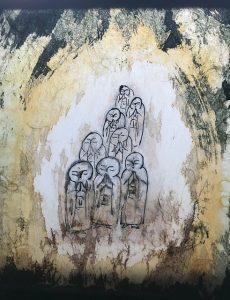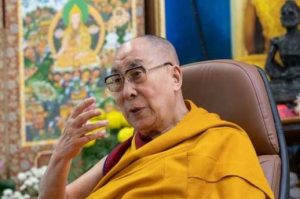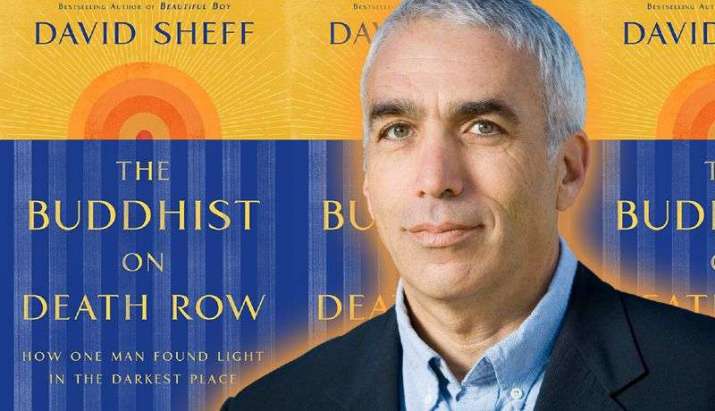
A new book by journalist David Sheff relates the remarkable and inspiring story of Jarvis Jay Masters, a long-time Buddhist practitioner and author who has been on death row in California for more than 30 years. The Buddhist on Death Row: How One Man Found Light in the Darkest Place (Simon and Schuster), released last week, has gained widespread acclaim from reviewers for its careful telling of the story of a man whose life has been destroyed by systemic racism in the US, and who, despite this, has turned to Buddhist practice and a life of radical self-transformation.
Both Sheff and Masters, speaking from San Quentin State Prison, were interviewed by writer and activist Rebecca Solnit for San Francisco’s non-profit City Arts & Lectures series on 15 June and broadcast on public radio station KQED on 9, 11, and 12 August. They were also interviewed by NPR’s Scott Simon for Weekend Edition Saturday on 8 August. The story told in both interviews and from other sources is one of a man showing remarkable calmness and kindness amid the most challenging of circumstances.
Born in Long Beach, California, in 1962, Masters was raised in a house with no father present and a mother addicted to drugs. He was one of seven children, all of whom were taken into foster care. At a young age, Masters entered into a life of crime and was arrested in 1981 at the age of 19. He has been incarcerated at San Quentin ever since.
On 8 June 1985, San Quentin prison guard Sgt. Howell Burchfield was murdered while on duty. Three prisoners, including Masters, were tried for the killing and convicted, although only Masters was hadnded down a death sentence.
According to the non-profit journalist organization Injustice Watch, several serious problems quickly arose with the case filed against Masters, including his being misidentified by a key witness against him. That witness and two others later recanted their testimonies, saying that they had lied in hopes of receiving favorable treatment. Another inmate, Andre Johnson, who was convicted in the stabbing of Burchfield, also provided a “sworn statement that Masters had no role in the murder.” (Injustice Watch)
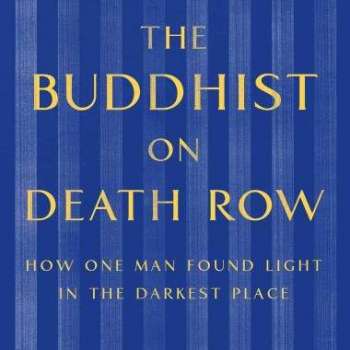
In this excerpt from The Buddhist on Death Row, Sheff recounts Masters’ experience after he was sentenced to death:
Late that night he heard footsteps and then pounding. He looked up into the blinding beams of flashlights held by guards, one of whom told him to step up to the bars. Jarvis thought they were there to kill him. Mob justice. A lynching. Shielding his eyes with his hands, trembling, he rose and stumbled forward.
“We have to read this,” a guard snapped. “You have to sign it.”
They weren’t there to kill him, after all, but to carry out the mandatory reading of the execution order. Jarvis signed the piece of paper that condemned him to die.
The next morning, breakfast was delivered as usual, and the day progressed as if nothing had changed. Also as usual, the mail was delivered in the evening. Jarvis examined a large envelope from someone named Lisa Leghorn, who in a note explained that she was an assistant and interpreter to Chagdud Tulku Rinpoche, the Buddhist lama Jarvis had written to months before. Leghorn wrote that Rinpoche was glad that Jarvis had reached out to him, and she referred to a small book in the package entitled Life in Relation to Death, which contained a transcript of a talk by the lama. “Read it,” she said. “See if it speaks to you.”
Jarvis picked the book up and was instantly transfixed. On the first page, the lama described death as a subject people often ignore or think about frivolously, as if it were no big deal. Then the author wrote, “This is a nice theory until one is dying. Then experience and theory differ.” He continued, “Then one is powerless and everything familiar is lost. One is overwhelmed by a great turbulence of fear, disorientation, and confusion. For this reason it is essential to prepare well in advance for the moment when the mind and body separate.”
Jarvis closed the book and breathed deeply. A familiar, choking emotion welled up in him: anguish. But he read on. The teacher said that all people should prepare for death, and one approach was to picture the ways they might die. He listed an airplane crash, an automobile accident, a terminal illness, and being stabbed by a mugger. He didn’t mention the gas chamber.
Another approach was called “meditative contemplations.” Jarvis read through them quickly until he got to one that made him shudder. People should ask themselves two questions every night before bed: “If I die tonight in my sleep . . . What have I done with my life? Have I been of benefit or have I caused harm?”
Jarvis needed no time to ponder his answer. He knew that he’d benefited no one and he’d caused immeasurable harm.
He read all night. Dawn was breaking as he turned the final page, but he was wide awake. He didn’t believe in omens, but he reeled at the thought that during his first day on death row, the mail had brought him a guide to dying. (AARP)
Over the course of his imprisonment, Masters developed relationships with several Buddhist teachers and became an author himself of two books chronicling his journey through Buddhism, prison, and life: Finding Freedom: Writings from Death Row (Padma Publishing 1997) and That Bird Has My Wings: The Autobiography of an Innocent Man on Death Row (HarperOne 2009).
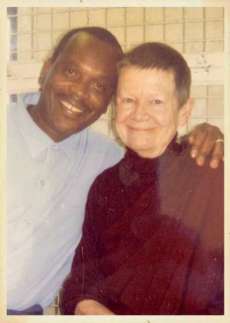
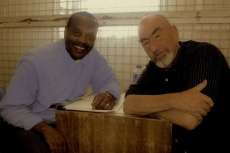
Despite Masters’ appeals, officials in the state refused to overturn his conviction. “In 2019, 29 years after Masters had been sentenced to death, the California Supreme Court affirmed his conviction and sentence.* The protracted state hearings left Masters unable before that ruling to turn to the federal courts, since he was required to first exhaust his state remedies.” (Injustice Watch)
When asked by Scott Simon over the weekend why he chose to write about Jarvis Jay Masters’ story, Sheff responded:
Well, I’d heard about Jarvis from friends who were in the Buddhist community. And the two things that I kept hearing over and over was that this man, who was framed, shouldn’t be on death row. And in spite of the fact that he was there and now it’s been, you know, 30 years and 22 years in solitary confinement, he was one of the most extraordinary people that they’d met. His story was really about how a person changes and the remarkable transformation, because he was a person who could be as bitter, angry as anybody could be, and yet he was the opposite. He was this light in the lives of many, many people. (NPR)
According to Alan Senauke, head of the non-profit Clear View Project, further appeals for the freedom of Jarvis Jay Masters will be made in the federal court system.
* California Court Affirms Death Sentence for Jarvis Jay Masters (Buddhistdoor Global)
See more
City Arts & Lectures presents The Buddhist on Death Row (YouTube)
David Sheff Charts Jarvis Jay Masters’ Buddhist Journey In Prison In New Book (NPR)
Jarvis Jay Masters: Accuser’s description of Masters matched inmate who confessed (Injustice Watch)
Read an Excerpt From ‘The Buddhist on Death Row’ (AAPR)
Justice Denied for Jarvis Masters (Clear View Project)





